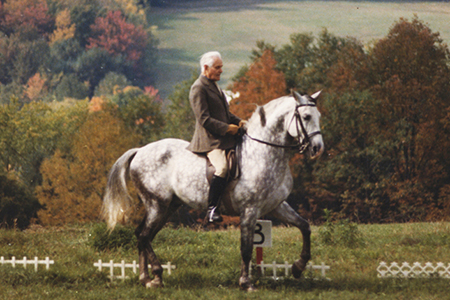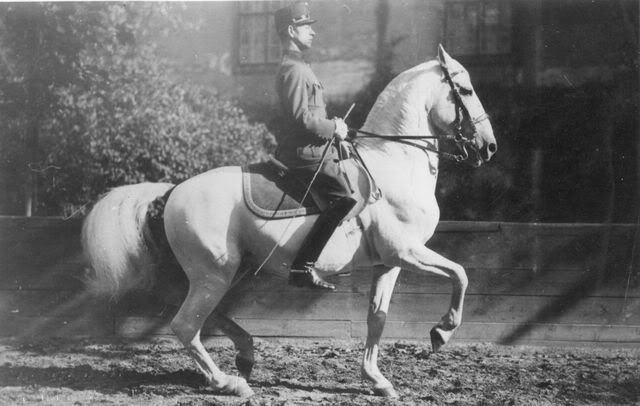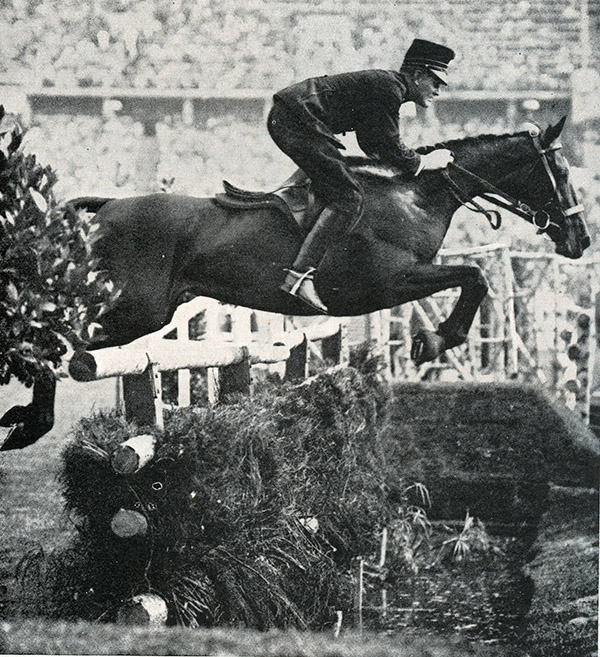
by H. L. M. van Schaik
Three decades ago that great defender of the Classical Principles, Henri van Schaik, wrote this passionate defense of Classical Equitation in the face of an FEI which he thought, just did not understand those principles… has anything changed? What is the current state of world dressage?
But first let’s hear from Dr van Schaik:
I have been called a crazy old mean and some people doubt if I am mentally still there. I am in good company, because when he was 78, the same happened to Waldemar Seunig, it was said that he was senile; he did ride two horses a day and had just published a book.
I no longer ride, I write. During the World Championships in Cedar Valley in 1986 somebody sitting in my neighbourhood made the following remark: ‘The quality of the horses is getting better and better, but the level of riding is going constantly down’. She could not have expressed herself better. This downward trend of Classical Equitation has been bothering me for at least 20 years and for the last ten years I have done a lot of thinking about this problem.
During one of my visits to Karlsruhe, I think it was 1979, Egon von Neindorff said to me: ‘You know, I think that we belong to an endangered species and I would like to do something about it. I am considering a round table conference.’ That conference never eventuated but the thinking it provoked informs this article.

Egon von Neindorff
I accuse the leadership of the FEI, and by association, all the national federations, of being responsible for the sorry state of Classical Equitation. There is no doubt in my mind that the functionaries of all these bodies are hard working and dedicated people, but they fail to protect the Equestrian Art from the abuses to which it can be exposed and to preserve it in the purity of its principles (FEI Article 418) They fail, because they lack the historical and theoretical knowledge to steer the right course for Classical Equitation.
Leonardo da Vinci once said: ‘Those who devote themselves to practice without science are like sailors who put to sea without a rudder or compass and who can never be certain where they are going. Practice must always be founded on sound theory.’
Now I want to focus on the changes that have happened since the beginning of the 20th century. In the first half of that century there occurred a drastic change in the relationship between man and horse. For centuries, life without horses had been unthinkable. In working the fields, in transportation and communication, and in the military, there had developed a close relationship between horses and man. One could not be without the other. Gradually, the need for horses to work the fields was more and more replaced by machinery. Then came the first World War when the first tanks made thier appearance on the battlefield. After the war, the armies needed far fewer horses than before.
In Germany, the slogan was Das Pferd musz bleiben – the horse shall stay. Gustav Rau got the bright idea to propagate horse-back riding for the children of farmers. The army had been a very important customer of the breeders – and ways had to be found to get new customers for breeders, Rau’s design worked and horse-back riding as a pastime became very popular. There were enough good teachers, former pupils of the military riding schools who had gone all through the rigid indoctrination as to how to deal with horses, and to ride them, and also how to teach.
After the second World War, the horse had definitely lost its place as an active part of the economy. It kept contributing to the economy as a means for sport and leisure. As the demand for teachers increased, teachers who had had their education in the military were not to be found anymore. The result was that a lot of enterprising young men and women, some with a little background, most with very little experience, started to teach and to school horses.
I shall never forget going in the early seventies with Waldemar Seunig to the big arena in München-Riem. I was amazed to see some twenty young men coming into the arena to work their horses – all of the horses, right from the beginning, pulled together. It was evident that these men, skilled riders as they might have been, had no sound theoretical knowledge. They were like the sailors of Leonardo, who went to sea without rudder or compass.
Unfortunately today this situation is world-wide. The reason for this is that today those men and women have to make a living and therefore they have to ‘produce’. The owners want to see results: flying changes, piaffe, passage, you name it. As a result, solid basic schooling that takes time is neglected, where the government paid the bill, basic schooling had the highest priority. The horses were a big investment, and therefore it was very important that they were schooled in such a way that, during peace time, they could serve well over fifteen years. In the military, no one could give instruction unless he had passed two years at the military riding school, and the same applied to remounts.
Today there is no more an ethical relationship between man and horse. Everybody claims that he loves his horse, but go into the warmup arena and see what is happening there. Today not only the schooling of horses lacks theoretical foundation, the instruction of riders, trainers and judges lacks theoretical foundation. Almost no-one understands the purpose of the movements we ask of the horse. Most judges do not know, instructors do not know. When somebody asked his instructor what the purpose of a certain movement was, the answer was: do not ask, do it. How can pupils, taught under such conditions, learn anything?
Another detrimental phenomenon today might be called ‘Variations’. We see a seeming urgency for innovations, sometimes among very able riders who go overboard and become a variety of acrobat. The other day I read in a French magazine about shoulder-in during a change of direction, and in a volte, and, of course, counter shoulder-in. Truly a variation – and a typical example of the maxim that variations other become deviations. These are consequences that ruin the real purpose of the shoulder-in which is basically a skill developing movement.
Having earlier berated the FEI for its sins of omission and commission, I must now praise the FEI for some action its Dressage Commission took recently. It ruled that piaffe backwards has no place in the freestyle. A Russian rider had performed this ‘variation’ and got away with the first prize. If only the FEI was as drastic will all other deviations.
How can Classical Equitation be saved?
We live in a time in which people want to be free, not tied to concepts of olden times. We should however not forget that Art has its own rules and reulations and that when we transgress these rules the Art gets lost. Therefore, we must remember the words of Charles Prosper, Chevalier le Vaillant de Saint Denis: ‘One must agree that if the true principles of the art had not been maintained, with a certain austerity in the royal riding school, in Versailles, if they had not been constantly practised, someday one might be hard pressed to find a way to renew the principles.’
These words were spoken in 1789 but hold true today. We must all work together to see that these principles of the Art of Classical Equitation are upheld and maintained by today’s judges, so that they can be passed on to the riders of today and those of future generations…

Henri van Schaik competing at the 1936 Games on Santa Bell
POSTSCRIPT: Dr van Schaik sounded his warning in 1989. I am glad that he never lived to see the era of Salinero, when dressage hit its nadir. I am sure he would have enjoyed the lightness and refinement of many of today’s top dressage horses, but sadly he would not have to look far from his birthplace in Holland, to see the sort of riding he was so anxious to clean out of dressage. The challenge remains, all it needs is good riding, classical training, and judges with the wit to see the difference… CH


